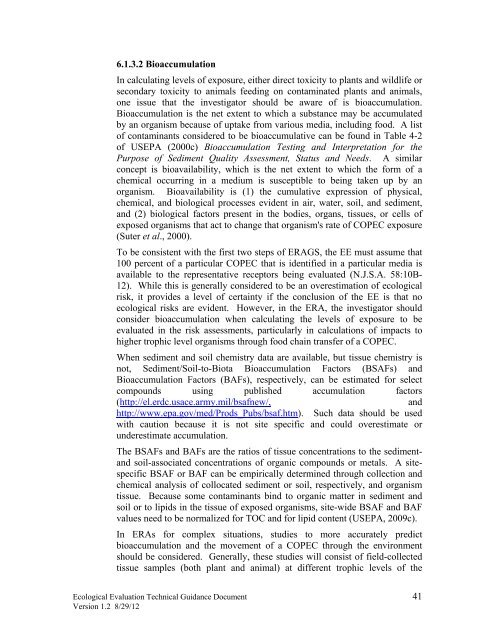Ecological Evaluation Technical Guidance - State of New Jersey
Ecological Evaluation Technical Guidance - State of New Jersey
Ecological Evaluation Technical Guidance - State of New Jersey
- No tags were found...
Create successful ePaper yourself
Turn your PDF publications into a flip-book with our unique Google optimized e-Paper software.
6.1.3.2 BioaccumulationIn calculating levels <strong>of</strong> exposure, either direct toxicity to plants and wildlife orsecondary toxicity to animals feeding on contaminated plants and animals,one issue that the investigator should be aware <strong>of</strong> is bioaccumulation.Bioaccumulation is the net extent to which a substance may be accumulatedby an organism because <strong>of</strong> uptake from various media, including food. A list<strong>of</strong> contaminants considered to be bioaccumulative can be found in Table 4-2<strong>of</strong> USEPA (2000c) Bioaccumulation Testing and Interpretation for thePurpose <strong>of</strong> Sediment Quality Assessment, Status and Needs. A similarconcept is bioavailability, which is the net extent to which the form <strong>of</strong> achemical occurring in a medium is susceptible to being taken up by anorganism. Bioavailability is (1) the cumulative expression <strong>of</strong> physical,chemical, and biological processes evident in air, water, soil, and sediment,and (2) biological factors present in the bodies, organs, tissues, or cells <strong>of</strong>exposed organisms that act to change that organism's rate <strong>of</strong> COPEC exposure(Suter et al., 2000).To be consistent with the first two steps <strong>of</strong> ERAGS, the EE must assume that100 percent <strong>of</strong> a particular COPEC that is identified in a particular media isavailable to the representative receptors being evaluated (N.J.S.A. 58:10B-12). While this is generally considered to be an overestimation <strong>of</strong> ecologicalrisk, it provides a level <strong>of</strong> certainty if the conclusion <strong>of</strong> the EE is that noecological risks are evident. However, in the ERA, the investigator shouldconsider bioaccumulation when calculating the levels <strong>of</strong> exposure to beevaluated in the risk assessments, particularly in calculations <strong>of</strong> impacts tohigher trophic level organisms through food chain transfer <strong>of</strong> a COPEC.When sediment and soil chemistry data are available, but tissue chemistry isnot, Sediment/Soil-to-Biota Bioaccumulation Factors (BSAFs) andBioaccumulation Factors (BAFs), respectively, can be estimated for selectcompounds using published accumulation factors(http://el.erdc.usace.army.mil/bsafnew/,andhttp://www.epa.gov/med/Prods_Pubs/bsaf.htm). Such data should be usedwith caution because it is not site specific and could overestimate orunderestimate accumulation.The BSAFs and BAFs are the ratios <strong>of</strong> tissue concentrations to the sedimentandsoil-associated concentrations <strong>of</strong> organic compounds or metals. A sitespecificBSAF or BAF can be empirically determined through collection andchemical analysis <strong>of</strong> collocated sediment or soil, respectively, and organismtissue. Because some contaminants bind to organic matter in sediment andsoil or to lipids in the tissue <strong>of</strong> exposed organisms, site-wide BSAF and BAFvalues need to be normalized for TOC and for lipid content (USEPA, 2009c).In ERAs for complex situations, studies to more accurately predictbioaccumulation and the movement <strong>of</strong> a COPEC through the environmentshould be considered. Generally, these studies will consist <strong>of</strong> field-collectedtissue samples (both plant and animal) at different trophic levels <strong>of</strong> the<strong>Ecological</strong> <strong>Evaluation</strong> <strong>Technical</strong> <strong>Guidance</strong> Document 41Version 1.2 8/29/12
















